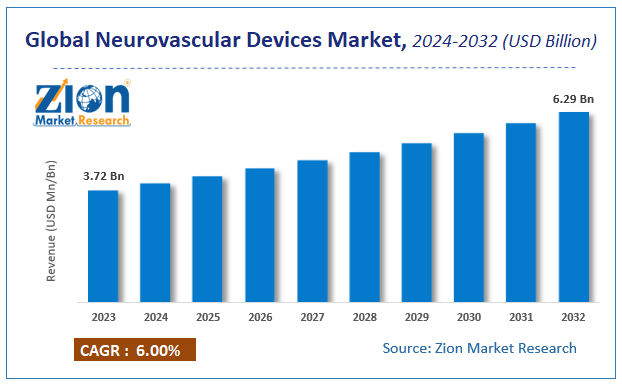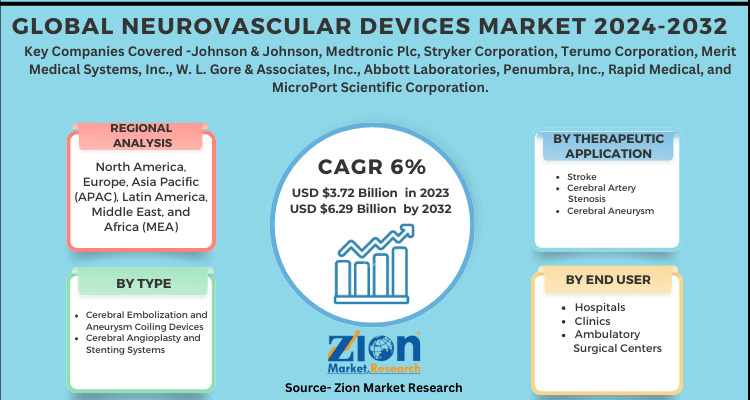Neurovascular Devices Market Growth, Size, Share, Trends, and Forecast 2032

Neurovascular Devices Market By Type (Cerebral Embolization and Aneurysm Coiling Devices, Cerebral Angioplasty and Stenting Systems, Neurothrombectomy Devices, and Support Devices), By Therapeutic Application (Stroke, Cerebral Artery Stenosis, Cerebral Aneurysm, and Others), and By End-User (Hospitals, Clinics and Ambulatory Surgical Centers), and By Region: Global Industry Perspective, Comprehensive Analysis, and Forecast, 2024-2032
| Market Size in 2023 | Market Forecast in 2032 | CAGR (in %) | Base Year |
|---|---|---|---|
| USD 3.72 Billion | USD 6.29 Billion | 6% | 2023 |
Neurovascular Devices Industry Prospective:
The global Neurovascular Devices market size accrued earnings worth approximately USD 3.72 Billion in 2023 and is predicted to gain revenue of about USD 6.29 Billion by 2032, is set to record a CAGR of nearly 6% over the period from 2024 to 2032.
The study includes drivers and restraints of the neurovascular devices market along with their impact on the demand over the forecast period. Additionally, the report includes the study of opportunities available in the neurovascular devices market on a global level.
Neurovascular Devices Market: Overview
In order to give the users of this report a comprehensive view of the neurovascular devices market, we have included a competitive landscape and an analysis of Porter’s Five Forces model for the market. The study encompasses a market attractiveness analysis, wherein all the segments are benchmarked based on their market size, growth rate, and general attractiveness.
Neurovascular devices are used to treat neurovascular diseases or disorders. Neurovascular diseases are caused when the blood vessels in the brain or spinal cord function abnormally. The abnormality of the blood vessels may lead to stroke, aneurysm, and stenosis, among other neurovascular diseases.
Neurovascular Devices Market: Growth Factors
According to the CDC (Centers for Disease Control and Prevention), about 795,000 people in the U.S. suffer from stroke annually. The growing prevalence of neurovascular diseases like stroke is mainly fueling the neurovascular devices market globally. According to the Internet Stroke Center, about 75% of strokes occur in the population aged above 65. It is also observed that the risk of stroke doubles above the age of 55. The growing number of baby boomers in Europe, Asia Pacific, and America are also driving the neurovascular devices market globally.
The increase in government reimbursement policies for the treatment of neurovascular disease, rise in product development and product launches by companies due to rising competition, and rapid innovation in neurovascular devices are other major factors supporting the global neurovascular devices market. However, the lack of skilled professionals who can effectively handle these devices, the high cost of these devices, and stringent regulations for acceptance of new products are hampering the neurovascular devices market globally.
The report provides company market share analysis to give a broader overview of the key players in the market. In addition, the report also covers key strategic developments of the market including acquisitions & mergers, new assay kits launch, agreements, partnerships, collaborations & joint ventures, research & development, and regional expansion of major participants involved in the market.
Neurovascular Devices Market: Segmentation
The global neurovascular devices market is divided into type, application, and end-user.
By type, the market for neurovascular devices is segmented into cerebral angioplasty and stenting systems, neurothrombectomy devices, cerebral embolization and aneurysm coiling devices, and support devices. The cerebral embolization and aneurysm coiling devices segment further includes flow diversion devices, liquid embolic agents, and embolic cells. The cerebral angioplasty and stenting systems segment is further divided into embolic protection systems and carotid artery stents. The neurothrombectomy devices are further segmented into vascular snares, suction devices, and clot retrieval devices. The support devices segment is further divided into microcatheters and micro guidewires. The cerebral embolization and aneurysm coiling devices segment dominated the neurovascular devices market in 2022.
By therapeutic application, the neurovascular devices market is segmented into cerebral artery stenosis, stroke, cerebral aneurysm, and others. Cerebral aneurysms are expected to demonstrate high growth in the future.
By end-user, the market is fragmented into ambulatory surgical centers, clinics, and hospitals. Hospitals dominated the neurovascular devices market globally in 2022.
| Report Attributes | Report Details |
|---|---|
| Report Name | Neurovascular Devices Market |
| Market Size in 2023 | USD 3.72 Billion |
| Market Forecast in 2032 | USD 6.29 Billion |
| Growth Rate | CAGR of 6% |
| Number of Pages | 205 |
| Key Companies Covered | Johnson & Johnson, Medtronic Plc, Stryker Corporation, Terumo Corporation, Merit Medical Systems, Inc., W. L. Gore & Associates, Inc., Abbott Laboratories, Penumbra, Inc., Rapid Medical, and MicroPort Scientific Corporation |
| Segments Covered | By type, By therapeutic application, By end-user and By Region |
| Regions Covered | North America, Europe, Asia Pacific (APAC), Latin America, Middle East, and Africa (MEA) |
| Base Year | 2023 |
| Historical Year | 2018 to 2022 |
| Forecast Year | 2024 - 2032 |
| Customization Scope | Avail customized purchase options to meet your exact research needs. Request For Customization |
Neurovascular Devices Market: Regional Insights
North America dominated the market in 2018, owing to the growing prevalence of neurovascular diseases, such as aneurysm, intracranial atherosclerotic disease, stenosis, arteriovenous malformations, etc., mainly in the U.S. and the early introduction of technologically advanced products. The Asia Pacific neurovascular devices market is anticipated to show the highest growth rate over the forecast time period, due to the rapidly growing geriatric population suffering from neurovascular diseases, increasing investments made by leading companies to develop advanced neurovascular devices, and the rising number of new device launches in developing countries like India and China.
Neurovascular Devices Market: Competitive Space
The global neurovascular devices market profiles key players such as:
- Johnson & Johnson
- Medtronic Plc
- Stryker Corporation
- Terumo Corporation
- Merit Medical Systems, Inc
- W. L. Gore & Associates, Inc
- Abbott Laboratories
- Penumbra, Inc
- Rapid Medical
- MicroPort Scientific Corporation
This report segments the global neurovascular devices market into:
Global Neurovascular Devices Market: Type Analysis
- Cerebral Embolization and Aneurysm Coiling Devices
- Embolic Coils
- Flow Diversion Devices
- Liquid Embolic Agents
- Cerebral Angioplasty and Stenting Systems
- Carotid Artery Stents
- Embolic Protection Systems
- Neurothrombectomy Devices
- Clot retrieval Devices
- Suction Devices
- Vascular Snares
- Support Devices
- Micro Catheters
- Micro Guidewires
Global Neurovascular Devices Market: Therapeutic Application Analysis
- Stroke
- Cerebral Artery Stenosis
- Cerebral Aneurysm
- Others
Global Neurovascular Devices Market: End-User Analysis
- Hospitals
- Clinics
- Ambulatory Surgical Centers
Global Neurovascular Devices Market: Regional Analysis
- North America
- U.S.
- Europe
- UK
- France
- Germany
- Asia Pacific
- China
- Japan
- India
- Latin America
- Brazil
- Middle East and Africa
Table Of Content
Methodology
FrequentlyAsked Questions
Neurovascular devices are medical technologies and instruments that are intended to diagnose and treat conditions that impinge on the blood vessels of the brain and nervous system. Strokes, aneurysms, arteriovenous malformations (AVMs), and other cerebrovascular disorders are usually treated with these devices. Neurovascular devices assist in the restoration of appropriate blood flow or the resolution of issues within the brain's vascular system.
The demand for neurovascular devices is being driven by the rising prevalence of conditions such as strokes, brain aneurysms, and AVMs. Demand for these disorders is further augmented by the fact that the ageing population is particularly susceptible to them.
The global Neurovascular Devices market size accrued earnings worth approximately USD 3.72 Billion in 2023 and is predicted to gain revenue of about USD 6.29 Billion by 2032.
The global Neurovascular Devices market a CAGR of nearly 6% over the period from 2024 to 2032.
The regional segment includes the current and forecast demand for North America, Europe, Asia Pacific, Latin America, and the Middle East and Africa with its further divided into major countries including the U.S., UK, Germany, France, China, Japan, India, Brazil, etc.
Some key players of the global neurovascular devices market are Johnson & Johnson, Medtronic Plc, Stryker Corporation, Terumo Corporation, Merit Medical Systems, Inc., W. L. Gore & Associates, Inc., Abbott Laboratories, Penumbra, Inc., Rapid Medical, and MicroPort Scientific Corporation.
RelatedNews
HappyClients
Zion Market Research
Tel: +1 (302) 444-0166
USA/Canada Toll Free No.+1 (855) 465-4651
3rd Floor,
Mrunal Paradise, Opp Maharaja Hotel,
Pimple Gurav, Pune 411061,
Maharashtra, India
Phone No +91 7768 006 007, +91 7768 006 008
US OFFICE NO +1 (302) 444-0166
US/CAN TOLL FREE +1 (855) 465-4651
Email: sales@zionmarketresearch.com
We have secured system to process your transaction.
Our support available to help you 24 hours a day, five days a week.
Monday - Friday: 9AM - 6PM
Saturday - Sunday: Closed







